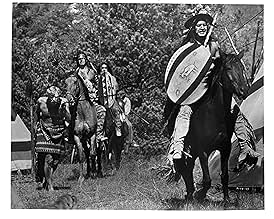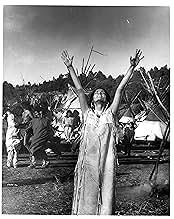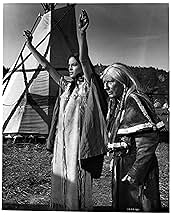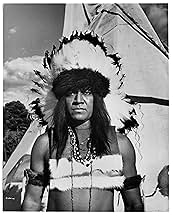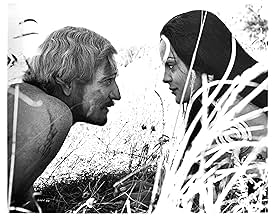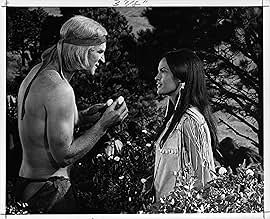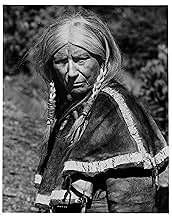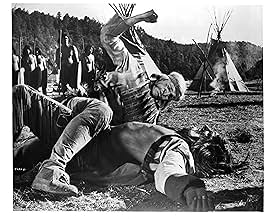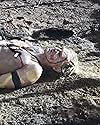IMDb रेटिंग
6.8/10
9.9 हज़ार
आपकी रेटिंग
अपनी भाषा में प्लॉट जोड़ेंIn 1825, an English aristocrat is captured by Native Americans. He lives with them and begins to understand their way of life. Eventually, he is accepted as part of the tribe and aspires to ... सभी पढ़ेंIn 1825, an English aristocrat is captured by Native Americans. He lives with them and begins to understand their way of life. Eventually, he is accepted as part of the tribe and aspires to become their leader.In 1825, an English aristocrat is captured by Native Americans. He lives with them and begins to understand their way of life. Eventually, he is accepted as part of the tribe and aspires to become their leader.
- निर्देशक
- लेखक
- स्टार
- पुरस्कार
- 1 जीत और कुल 2 नामांकन
Judith Anderson
- Buffalo Cow Head
- (as Dame Judith Anderson)
Lina Marín
- Thorn Rose
- (as Lina Marin)
फ़ीचर्ड समीक्षाएं
"A Man Called Horse" is a very unusual film about the west for many reasons. It's NOT set during the usual 'glory days' when most films of the type were set (1866-1880). It had no cowboys. And, it had very little dialog in English.
The film begins with a rich Englishman, John Morgan (Richard Harris), on a hunting expedition in the American West in the 1830s. He and his party are attacked by Sioux warriors and Morgan is taken prisoner by the natives. At first, he's treated like a slave and his life truly sucks. It didn't help that the only one who spoke any English in the tribe was another slave who was French...and the guy was a little nuts! Through the course of the film, however, Morgan learns to respect and even enjoy life with the Sioux and becomes an important member of the tribe. There is naturally much more to it than that but it's best you just see it for yourself.
This movie is almost like an ethnographic portrait of the Sioux and the times instead of a typical western film. The usual sorts of clichés and expectations are mostly missing. Some will hate this--some will no doubt be relieved. All I know is that I enjoyed it and liked the more intimate and native-centered approach of the film. Well made all around...though the sun ceremony is NOT for the squeamish.
The film begins with a rich Englishman, John Morgan (Richard Harris), on a hunting expedition in the American West in the 1830s. He and his party are attacked by Sioux warriors and Morgan is taken prisoner by the natives. At first, he's treated like a slave and his life truly sucks. It didn't help that the only one who spoke any English in the tribe was another slave who was French...and the guy was a little nuts! Through the course of the film, however, Morgan learns to respect and even enjoy life with the Sioux and becomes an important member of the tribe. There is naturally much more to it than that but it's best you just see it for yourself.
This movie is almost like an ethnographic portrait of the Sioux and the times instead of a typical western film. The usual sorts of clichés and expectations are mostly missing. Some will hate this--some will no doubt be relieved. All I know is that I enjoyed it and liked the more intimate and native-centered approach of the film. Well made all around...though the sun ceremony is NOT for the squeamish.
This movie offered a different perspective of the Sioux, and although controversial, it is worth a view. Director Elliot Silverstein doesn't glamorize the Indians and he doesn't make them victims of white injustice. He just tells it like it is, and I have to admire him for it. Many activists protested what they believed to be inaccuracies; nonetheless, the film is the other side of "Dances With Wolves" (really, it's more like "Run of the Arrow"). For an in-depth interview with Silverstein and the making of "A Man Called Horse," read "Making the White Man's Indian: Native Americns and Hollywood Movies." It's a great behind-the-scenes read of this and other popular Western pictures.
I have to laugh sometimes when I read otherwise sane comments from amateur reviewers. This film has fairly awkward productions values compared to the present, also many of the actors playing native people are very much NOT native. That aside, this is a BREAKTHROUGH movie for Hollywood circa 1970. This movie is not similiar to Dances With Wolves-it's effectively the other way around. I find it strange so many people make that comment. This movie predates the other by more than THIRTY YEARS!!! Anyway ackward production values aside the presentation of the Lakota is far from the touchy feely view Costner presented,we see the brutal side of their way of doing things also, which is as factual as what we see today just not very PC. This is a great period classic,well worth watching.
I first saw this film in the theatre when it came out in 1970. It was a welcome departure from earlier films about pioneers sitting among their circled wagons shooting whooping Indians like ducks in an arcade.
I saw it last weekend for the first time since, and I think that it holds up well. Whatever the flaws, it is a reasonably good depiction of Dakota Sioux going about their business in the 1820s.
This movie demonstrates that a story can be told with very little dialog and a lot of non-verbal expression. Harris might be the most prominent character but, cumulatively, the cast of small characters weighs in just as heavy.
I saw it last weekend for the first time since, and I think that it holds up well. Whatever the flaws, it is a reasonably good depiction of Dakota Sioux going about their business in the 1820s.
This movie demonstrates that a story can be told with very little dialog and a lot of non-verbal expression. Harris might be the most prominent character but, cumulatively, the cast of small characters weighs in just as heavy.
One of the first films to ever deal with the relationship between white men and Native Americans that wasn't slanted towards the white man, A MAN CALLED HORSE was released during the same year as the excellent Arthur Penn film LITTLE BIG MAN and the ultra-violent SOLDIER BLUE, which also dealt with the white man/Indian conflict. Richard Harris gives a great performance as an Englishman who loses his wagon team to, and is captured by, a group of Sioux Indians in the Dakota territory of the mid-1800s. He soon learns their ways of living, which primitive as they might be to us and to him are very traditional. Though the film is rated 'PG', be forewarned that there are scenes of violence and bloodshed (particularly the Sun Vow sequence) that could have gotten this film an 'R' (or a 'PG-13'), so the film is not exactly for kids. Nevertheless, it is worth seeing.
क्या आपको पता है
- ट्रिवियाThe story is based on the experience of Cabeza de Vaca, a Spanish soldier captured by indigenous Americans in 1528.
- गूफ़Throughout the film the actress playing Running Deer can be seen with medium long, nicely manicured fingernails.
- इसके अलावा अन्य वर्जनOld German VHS version includes many alternate/more violent takes that are not on the US DVD (whereas the version on the DVD is the same as in the US), especially the ending is almost completely recut. On the other hand the US version includes a few lines which are not in the German version.
- कनेक्शनEdited into Commercial Entertainment Product (1992)
टॉप पसंद
रेटिंग देने के लिए साइन-इन करें और वैयक्तिकृत सुझावों के लिए वॉचलिस्ट करें
विवरण
- रिलीज़ की तारीख़
- कंट्री ऑफ़ ओरिजिन
- भाषाएं
- इस रूप में भी जाना जाता है
- Un hombre llamado Caballo
- फ़िल्माने की जगहें
- उत्पादन कंपनियां
- IMDbPro पर और कंपनी क्रेडिट देखें
बॉक्स ऑफ़िस
- US और कनाडा में सकल
- $19,41,247
- दुनिया भर में सकल
- $4,40,00,000
- चलने की अवधि
- 1 घं 54 मि(114 min)
- ध्वनि मिश्रण
- पक्ष अनुपात
- 2.35 : 1
इस पेज में योगदान दें
किसी बदलाव का सुझाव दें या अनुपलब्ध कॉन्टेंट जोड़ें


